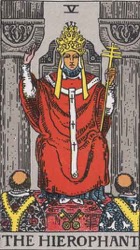The Hierophant Tarot Card Meaning & Interpretations

The Hierophant, also called The Pope or The High Priest, represents conservatism, conformity, doctrine and dogma. He embodies the written word that is accepted as truth without question. This is an important point to remember in distinguishing The High Priest from the The High Priestess. She represents hidden, secret, esoteric spiritual truth. He represents knowledge and truth as written down by academics, media, politicians, government or the church. This card can represent hierarchy and bureaucracy or a leader of an institution. It can also sometimes refer to a marriage ceremony.
The Hierophant is card number 5 of Tarot's Major Arcana. In the minor arcana all the cards that have the same numerical value, the 5 Of Wands, the 5 Of Pentacles, the 5 Of Swords, and the 5 Of Cups, are problematic cards representing strife, hardship, conflict and grief respectively. In numerology the number 5's negative characteristics are instability, chaos, self-indulgence, irresponsibility or carelessness. The positive characteristics of the 5 are freedom, versatility, flexibility, adaptability. It is difficult to see how a card that represents conservatism and conformity, such as The Hierophant, is a good representation of its numerology.
There’s a beautiful structure to tarot that connects minor cards to major superiors. e.g The Magician and the Aces, The Fool and the Pages, The Chariot and the Knights, The Empress and the Queens, The Emperor and the Kings. The recurring theme between these minor elementals and their major superior is that the superior has mastered all the elements in a harmony relating to the numerology. Therefore The Hierophant represents a system of control that contains and restrains the chaos and disfunctionality seen in its minor cards. Rules, and laws, are created to bring order to chaos.
The grieving person in the 5 Of Cups may find peace in their religion or be consoled by a priest, a psychologist or grief counsellor. The man in the 5 Of Swords taking he wants by force and open confrontation maybe prevented, or dissuaded, from doing so by law and law enforcement. The poor and injured couple in the 5 Of Pentacles are seen, in the RWS deck, walking past the stained glass window of a church. The solution to their immediate plight maybe the charity of an institution like the church or the social care of their government. The 5 labourers in the 5 Of Wands may find a solution to their inability to bring their structure together by consulting an architect who could provide them with building plans. All of the solutions given for each of these 4 minor cards are examples of what the Hierophant can symbolise.
The Hierophant is however an imperfect solution as rules and laws are often broken and the freedom loving 5 is more inclined to do so than any other number. For a better solution refer to the other number 5 in the Major Arcana, card number 14, Temperance which is symbolic of self control instead of the external control symbolised by The Hierophant.
© Phuture Me Ltd 2010-2019. All rights reserved.
THE PICTORIAL KEY TO THE TAROT
By Arthur Edward Waite (1911)
He wears the triple crown and is seated between two pillars, but they are not those of the Temple which is guarded by the High Priestess. In his left hand he holds a scepter terminating in the triple cross, and with his right hand he gives the well-known ecclesiastical sign which is called that of esotericism, distinguishing between the manifest and concealed part of doctrine. It is noticeable in this connection that the High Priestess makes no sign. At his feet are the crossed keys, and two priestly ministers in albs kneel before him. He has been usually called the Pope, which is a particular application of the more general office that he symbolizes. He is the ruling power of external religion, as the High Priestess is the prevailing genius of the esoteric, withdrawn power. The proper meanings of this card have suffered woeful admixture from nearly all hands. Grand Orient says truly that the Hierophant is the power of the keys, esoteric orthodox doctrine, and the outer side of the life which leads to the doctrine; but he is certainly not the prince of occult doctrine, as another commentator has suggested.
He is rather the summa totius theologiæ, when it has passed into the utmost rigidity of expression; but he symbolizes also all things that are righteous and sacred on the manifest side. As such, he is the channel of grace belonging to the world of institution as distinct from that of Nature, and he is the leader of salvation for the human race at large. He is the order and the head of the recognized hierarchy, which is the reflection of another and greater hierarchic order; but it may so happen that the pontiff forgets the significance of this his symbolic state and acts as if he contained within his proper measures all that his sign signifies or his symbol seeks to shew forth. He is not, as it has been thought, philosophy-except on the theological side; he is not inspiration; and he is not religion, although he is a mode of its expression.
Related Tarot Cards
 |
 |
 |
 |
 |
© Phuture Me Ltd 2018. All rights reserved.
